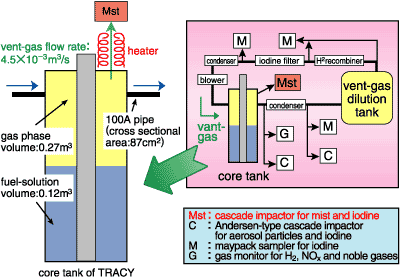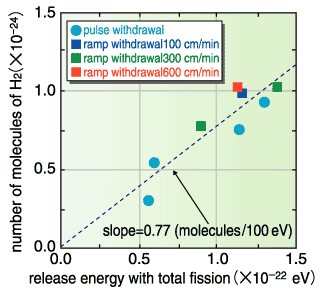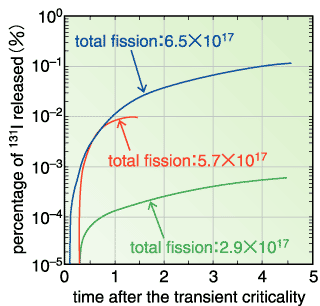To determine the safety margin and exposure dose of people at a critical accident in fuel cycle facilities, radioactivity released from uranium solution stored in a core tank was measured under criticality using the Transient Experiment Critical Facility (TRACY) of NUCEF. In the test, the release behavior of hydrogen gas and radioactive materials (noble gases, iodine, and aerosol) from the tank was investigated during the criticality.
Figure 11-10 shows a schematic of the tank where measuring devices for the various radiolysis gases and sampling traps for other radioactive materials, were attached to a vent-gas line of TRACY. At criticality, hydrogen is generated by the radiolysis of water due to the energy of fission fragments and critical radiation in the uranium solution, and this hydrogen gas is released in the tank with radioactive materials. Figure 11-11 shows the G-value of hydrogen gas release, which is the number of hydrogen molecules released per 100 eV of fission energy under critical conditions. The G-value in the figure serves not only as a method of preventing hydrogen gas explosion, but also as a way of studying the release mechanism of mists and aerosol particles generated by a rupture of hydrogen bubbles at the pool surface in the tank. Figure 11-12 shows the percentage of 131I released to the gas phase vs. the time after the transient criticality; these data were collected at a temperature below the boiling point of the uranium solution. It was found that the percentage value in the figure is markedly lower than that of a criticality at a design based accident (DBA) in a reprocessing plant (= 25%). The information from this TRACY test is expected to be used in criticality safety evaluations at fuel cycle facilities, especially reprocessing plants. In the JCO critical accident, these test data were used to evaluate the sequence of the accident, and were also made use of in the safety management at the accident. |


